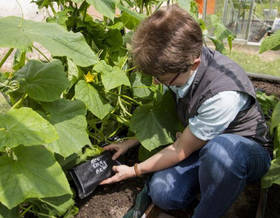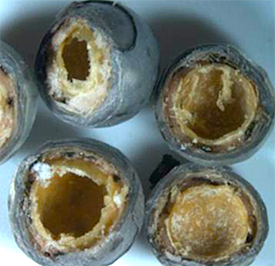 The Phase Change Matters e-mail newsletter is a weekly summary of the latest news and research on phase change materials and thermal energy storage. To subscribe, visit www.puretemp.com/subscribe. For more frequent updates, follow @puretemp on Twitter or visit the Phase Change Matters blog, www.puretemp.com/pcmatters.
The Phase Change Matters e-mail newsletter is a weekly summary of the latest news and research on phase change materials and thermal energy storage. To subscribe, visit www.puretemp.com/subscribe. For more frequent updates, follow @puretemp on Twitter or visit the Phase Change Matters blog, www.puretemp.com/pcmatters.
AGRICULTURE
German researchers roll out warming mat for greenhouse plants
Researchers at the University of Zwickau’s Institute for Textile and Leather Technologies are developing a latent heat storage mat that uses phase change material to increase plant root temperatures.
 The passive system, designed for use in greenhouses, requires no additional energy supply. Dr. Silke Hessberg, who is directing the research, says root climate control promotes plant growth efficiently.
The passive system, designed for use in greenhouses, requires no additional energy supply. Dr. Silke Hessberg, who is directing the research, says root climate control promotes plant growth efficiently.
“There are already various heating systems on the market, such as underfloor heating systems, hot water systems or electric and gas heaters,” she says. “These are always cost-intensive heating systems, since energy must be actively supplied.”
The Thuringian Institute of Textile and Plastics Research (TITK) is supporting the two-year project. TITK’s Martin Geissenhöner identifies the PCM as paraffin.
“We have different melting points. For the root project we use melting points between 5 and 42° C, specially 17° C,” he says. “The PCM is encapsulated in a network polymer. It’s like a sponge structure.”
Research associate Nancy Schrader says the mats are placed on the soil surface. Work on the project began in May 2015 and is expected to conclude in December.
PATENTS
Temperature stabilized culture incubator
U.S. patent application 20170260492 (applicant Tokitae LLC, Bellevue, Wash.):
“Described embodiments include a culture incubator, method, and sensor circuit. A culture incubator includes an accessible incubation compartment configured to contain a culture item at a specified incubation temperature; a phase change material having a phase transition temperature over the specified incubation temperature; and a heat transfer element in thermal communication with the phase change material and configured to transfer heat to the phase change material. A sensor circuit is configured to acquire data indicative of a phase composition state of the phase change material. A manager circuit is configured to determine a difference between the phase composition state and a target phase composition state for the phase change material. A controller circuit is configured to transfer heat to the phase change material in an amount estimated to change the phase composition state of the phase change material to the target phase composition state.”
Enhanced metal-metal-matrix composite weapon barrels
U.S. patent application 20170261280 (applicant Sapphire Defense Group LLC, Easley, S.C.):
“Weapon barrels are disclosed which offer improved thermal performance and rigidity with no, minimal or negative weight increase. In general the barrel comprises a barrel core surrounded by a lightweight, thermally conductive sleeve made from metal-matrix composite (MMC) materials, also referred to as metal-matrix material. The increased diameter of the sleeve improves the barrel’s stiffness and the sleeve’s thermal conductivity and distributes the heat more evenly along the barrel. … Hot spots may be reduced and more surface area can contribute to heat dissipation. The increased diameter also allows integration of phase changing and/or vibration dampening materials, which further enhance performance.”
IN BRIEF
 • The U.S. Department of Energy has released funding to the Argonne National Laboratory for a scaled-up round of independent testing of Terrafore Technologies’ encapsulated thermal energy storage in phase change salts. The materials are designed to operate in temperatures to greater than 800° C in a single tank that acts as both storage and heat exchanger.
• The U.S. Department of Energy has released funding to the Argonne National Laboratory for a scaled-up round of independent testing of Terrafore Technologies’ encapsulated thermal energy storage in phase change salts. The materials are designed to operate in temperatures to greater than 800° C in a single tank that acts as both storage and heat exchanger.
• The Department of Energy has invited Terrestrial Energy USA to submit the second part of its application for a federal loan guarantee to support the licensing and construction of its Integrated Molten Salt Reactor.
• Va-Q-tec AG is reporting a strong increase in its service business in the first half of 2017, up 54 percent to 8.8 million euros. The company, based in Würzburg, Germany, develops, manufactures and sells vacuum insulation panels and phase change materials.
• New from Zion Market Research: “Global thermal storage market is expected to reach USD 5.7 billion in 2022, growing at a CAGR of 10.7% between 2017 and 2022”
• DLR has fired up the TESIS thermal storage facility in Cologne, Germany. One hundred tons of molten salt is alternately heated and cooled from 250 to 560 degrees Celsius in the test facility, which is designed to allow industrial-scale testing of temporary storage methods for renewable energy and waste heat.
• Advanced combat clothing featuring “four-way stretch phase-change material” was on display last week at the annual Defense and Security Equipment International show in London. Royal College of Art researchers and designers collaborated with the Ministry of Defense on the prototypes, which are designed to be easy to run in and comfortable to wear.
RESEARCH ROUNDUP
For our full list of recent academic research, see puretemp.com/academic. Here are highlights from the past week:
From Energy Procedia:• Energetic performance of two different PCM wallboards and their regeneration behavior in office rooms
• Correlation between energy efficiency in buildings and comfort of the users
• Numerical study of a composite Trombe solar wall integrating microencapsulated PCM
From Sustainable Cities and Society:
• Design of High Temperature Thermal Energy Storage for High Power Levels
From Applied Thermal Engineering:
• Numerical analysis of heat transfer processes in a low-cost, high-performance ice storage device for residential applications
• Solid-liquid phase change investigation through a double pipe heat exchanger dealing with time-dependent boundary conditions
From Applied Energy:
• Evaluation of energy efficient hybrid hollow plaster panel using phase change material/xGnP composites
• Indoor thermal comfort assessment using different constructive solutions incorporating PCM
From Solar Energy Materials and Solar Cells:
• The experimental phase diagram study of the binary polyols system erythritol-xylitol
From Materials Science and Engineering: B:
• Multifunctional poly (melamine-urea-formaldehyde)/graphene microcapsules with low infrared emissivity and high thermal conductivity
From Journal of Power and Energy Engineering:
• Melting and Solidification Heat Transfer Characteristics of a Phase-Change Material in a Latent Heat Storage Vessel: Effects of a Perforated Partition Plate and Metal Fiber
NETWORKING
Connect with PCM experts and industry leaders on LinkedIn
More than a thousand of your peers have joined a LinkedIn group devoted to the discussion of phase change material and thermal energy storage. The Phase Change Matters group is an interactive complement to the award-winning blog and newsletter of the same name.
 You are invited to join the group and connect with PCM and TES experts from around the world. New members include Pradip Varpe, electronics and telecommunication engineer, Pune, India; Bharat Chhugani, scientific assistant at ZAE Bayern, Würzburg, Germany; Stéphane Lassue, professor at University of Artois LGCgE, Lille, France; Hervé Leuck, technical director at MCI Technologies Inc., Saint-Julien, France; and Andrea Mammoli, professor at University of New Mexico, Albuquerque, N.M.
You are invited to join the group and connect with PCM and TES experts from around the world. New members include Pradip Varpe, electronics and telecommunication engineer, Pune, India; Bharat Chhugani, scientific assistant at ZAE Bayern, Würzburg, Germany; Stéphane Lassue, professor at University of Artois LGCgE, Lille, France; Hervé Leuck, technical director at MCI Technologies Inc., Saint-Julien, France; and Andrea Mammoli, professor at University of New Mexico, Albuquerque, N.M.